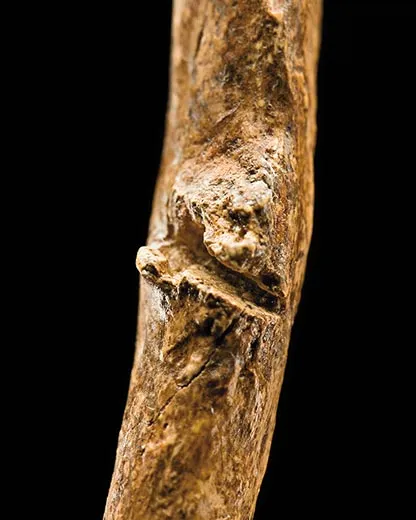The Skeletons of Shanidar Cave
A rare cache of hominid fossils from the Kurdistan area of northern Iraq offers a window on Neanderthal culture
/https://tf-cmsv2-smithsonianmag-media.s3.amazonaws.com/filer/neanderthal-burial-scene-Shanidar-cave-631.jpg)
1n 1856, laborers working in a limestone quarry in the Neander Valley near Düsseldorf, Germany, dug up some unusual-looking bones. Subsequent study revealed that they belonged to a previously unknown species of humans, similar to, but distinct from our own species, Homo sapiens. The newly discovered hominid was named Neanderthal—thal is Old German for valley—and has fascinated anthropologists ever since.
It was first thought that Neanderthals may have resembled apes—with stooped posture and bent knees—more closely than modern humans. Then, in the 1950s, Smithsonian anthropologist Ralph Solecki, a team from Columbia University and Kurdish workers unearthed the fossilized bones of eight adult and two infant Neanderthal skeletons—spanning burials from 65,000 to 35,000 years ago—at a site known as the Shanidar cave, in the Kurdistan area of northern Iraq. The discovery changed our understanding of Neanderthals.
The early hominids walked upright and possessed a more sophisticated culture than had previously been assumed. One of the skeletons, excavated in 1957, is known simply as Shanidar 3. The male Neanderthal lived 35,000 to 45,000 years ago, was 40 to 50 years old and stood about 5-foot-6. Shanidar 3 now resides at the Smithsonian National Museum of Natural History, showcased inside a highly secure glass enclosure that Rick Potts, director of the museum’s Human Origins Program, describes as a “fossil treasure case.” Shanidar 3, Potts adds, “is the Hope Diamond of the Human Origins collection, and we treat it accordingly.”
Solecki’s pioneering studies of the Shanidar skeletons and their burials suggested complex socialization skills. From pollen found in one of the Shanidar graves, Solecki hypothesized that flowers had been buried with the Neanderthal dead—until then, such burials had been associated only with Cro-Magnons, the earliest known H. sapiens in Europe. “Someone in the last Ice Age,” Solecki wrote, “must have ranged the mountainside in the mournful task of collecting flowers for the dead.” Furthermore, Solecki continued, “It seems logical to us today that pretty things like flowers should be placed with the cherished dead, but to find flowers in a Neanderthal burial that took place about 60,000 years ago is another matter.” Skeletons showed evidence of injuries tended and healed—indications that the sick and wounded had been cared for. Solecki’s attitude toward them was encapsulated in the title of his 1971 book, Shanidar: The First Flower People.
Drawing on Solecki’s research, writer Jean Auel mixed fiction and archaeology in her novel, The Clan of the Cave Bear, a 1980 bestseller that humanized, if not glamorized, Neanderthals. In the book, the clan members adopt an orphaned Cro-Magnon child, who comprehends things beyond their ken, foreshadowing the Neanderthals’ fate. Out-competed by the Cro-Magnon, Neanderthals would become extinct.
According to Potts, climate change was the instrument of their demise. Around 33,000 years ago, the Neanderthal, who migrated south from their northernmost range in Central Europe as glaciers advanced, settled in the wooded regions of Iberia (present-day Spain and Portugal) and Gibraltar. There, they flourished, possibly until 28,000 years ago, when they were supplanted by a supremely adaptable competitor—the resilient Cro-Magnon.
Cro-Magnon groups, says Potts, who were “aided by their ability to make warmer, more form-fitting clothing, had already moved into the Neanderthals’ former territories.” Thus, Potts adds, “Modern humans gained a foothold they never relinquished.” The Neanderthals lived in ever smaller and more isolated areas—suffering what we now call loss of habitat—eventually vanishing from the earth.
“The Neanderthals were smart,” Potts says. “They had brains the same size as Cro-Magnon and were very clever at using local resources. They lacked the ability to expand their thinking and adapt to changing conditions.”
Shanidar 3’s own story, however, is grounded not in large evolutionary forces but in particular circumstances. “There is quite a severe and deep cut to a rib on [Shanidar 3’s] left side,” says Potts. “This cut would have been deep enough to collapse his lung, so Shanidar 3 is the oldest known individual who could have been murdered.”
Owen Edwards is a freelance writer and author of the book Elegant Solutions.
/https://tf-cmsv2-smithsonianmag-media.s3.amazonaws.com/accounts/headshot/Owen-Edwards-240.jpg)


/https://tf-cmsv2-smithsonianmag-media.s3.amazonaws.com/accounts/headshot/Owen-Edwards-240.jpg)